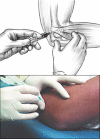Management of Tennis Elbow with sodium hyaluronate periarticular injections
- PMID: 20205851
- PMCID: PMC2825499
- DOI: 10.1186/1758-2555-2-4
Management of Tennis Elbow with sodium hyaluronate periarticular injections
Abstract
Objectives: To determine the efficacy and safety of peri-articular hyaluronic acid injections in chronic lateral epicondylosis (tennis elbow).
Design: Prospective randomized clinical trial in primary care sport medicine.
Patients: Three hundred and thirty one consecutive competitive racquette sport athletes with chronic (>3 months) lateral epicondylosis were administered 2 injections (first injection at baseline) into the subcutaneous tissue and muscle 1 cm. from the lateral epicondyle toward the primary point of pain using a two-dimensional fanning technique. A second injection was administered 1 week later.
Outcomes measures: Assessments were done at baseline, days 7, 14, 30, 90 and 356. Efficacy measures included patient's visual analogue scale (VAS) of pain at rest (0-100 mm) and following assessment of grip strength (0-100 mm). Grip strength was determined using a jamar hydraulic hand dynamometer. Other assessments included patients' global assessment of elbow injury (5 point categorical scale; 1 = no disability, 5 = maximal disability), patients' assessment of normal function/activity (5 point categorical scale), patients/physician satisfaction assessment (10 point categorical scale), time to return to pain-free and disability-free sport and adverse events as per WHO definition. Differences between groups were determined using an intent-to-treat ANOVA.
Results: Average age of the study population was 49 years (+/- 12 years). One hundred and sixty-five patients were randomized to the HA and 166 were randomized to the control groups. The change in VAS pain was -6.7 (+/- 2.0) for HA vs -1.3 (+/- 1.5) for control (p < 0.001). The VAS post handgrip was -7.8 (+/- 1.3) vs +0.3 (+/- 2.0) (p < 0.001) which corresponded to a significant improvement in grip of 2.6 kg in the HA vs control groups (p < 0.01). Statistically significant improvement in patients' global assessment of elbow injury (p < 0.02), patients' assessment of normal function/activity (p < 0.05) and patients/physician satisfaction assessment (p < 0.05) were also observed favoring the HA group. Time to return to pain-free and disability-free sport was 18 (+/- 11) days in the HA group but was not achieved in the control group. VAS changes were maintained in the HA group at each followup while those in the control significantly declined from baseline. Assessment of patient and physician satisfaction continued to favor the HA group at subsequent followup.
Conclusion: Peri-articular HA treatment for tennis elbow was significantly better than control in improving pain at rest and after maximal grip testing. Further, HA treatment was highly satisfactory by patients and physicians and resulted in better return to pain free sport compared to control.
Figures
Similar articles
-
Periarticular hyaluronic acid in acute ankle sprain.Clin J Sport Med. 2007 Jul;17(4):251-7. doi: 10.1097/JSM.0b013e3180f6169f. Clin J Sport Med. 2007. PMID: 17620777 Clinical Trial.
-
Original research: long-term efficacy and safety of periarticular hyaluronic acid in acute ankle sprain.Phys Sportsmed. 2009 Apr;37(1):64-70. doi: 10.3810/psm.2009.04.1684. Phys Sportsmed. 2009. PMID: 20048489 Clinical Trial.
-
The short-term effectiveness of low-level laser, phonophoresis, and iontophoresis in patients with lateral epicondylosis.J Hand Ther. 2019 Oct-Dec;32(4):417-425. doi: 10.1016/j.jht.2018.01.002. Epub 2018 Feb 13. J Hand Ther. 2019. PMID: 29452929 Clinical Trial.
-
Injection Therapy in Patients with Lateral Epicondylalgia: Hyaluronic Acid or Dextrose Prolotherapy? A Single-Blind, Randomized Clinical Trial.J Altern Complement Med. 2020 Dec;26(12):1169-1175. doi: 10.1089/acm.2020.0188. Epub 2020 Sep 15. J Altern Complement Med. 2020. PMID: 32931308 Clinical Trial.
-
A comparative study of the efficacy of ultrasonics and extracorporeal shock wave in the treatment of tennis elbow: a meta-analysis of randomized controlled trials.J Orthop Surg Res. 2019 Aug 6;14(1):248. doi: 10.1186/s13018-019-1290-y. J Orthop Surg Res. 2019. PMID: 31387611 Free PMC article. Review.
Cited by
-
Radiological interventions for soft tissue injuries in sport.Br J Radiol. 2012 Aug;85(1016):1186-93. doi: 10.1259/bjr/17349087. Epub 2012 May 2. Br J Radiol. 2012. PMID: 22553303 Free PMC article. Review.
-
Hyaluronic acid and tendon lesions.Muscles Ligaments Tendons J. 2016 Feb 13;5(4):264-9. doi: 10.11138/mltj/2015.5.4.264. eCollection 2015 Oct-Dec. Muscles Ligaments Tendons J. 2016. PMID: 26958533 Free PMC article. Review.
-
Efficacy and safety of hyaluronic acid (500-730kDa) Ultrasound-guided injections on painful tendinopathies: a prospective, open label, clinical study.Muscles Ligaments Tendons J. 2017 Sep 18;7(2):388-395. doi: 10.11138/mltj/2017.7.2.388. eCollection 2017 Apr-Jun. Muscles Ligaments Tendons J. 2017. PMID: 29264351 Free PMC article.
-
Tendinopathy: Pathophysiology, Therapeutic Options, and Role of Nutraceutics. A Narrative Literature Review.Medicina (Kaunas). 2019 Aug 7;55(8):447. doi: 10.3390/medicina55080447. Medicina (Kaunas). 2019. PMID: 31394838 Free PMC article. Review.
-
Hyaluronic acid injections for chronic tennis elbow.BMC Sports Sci Med Rehabil. 2022 Jan 12;14(1):8. doi: 10.1186/s13102-022-00399-0. BMC Sports Sci Med Rehabil. 2022. PMID: 35022075 Free PMC article.
References
LinkOut - more resources
Full Text Sources
Other Literature Sources
Medical


